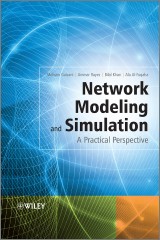Details

Network Modeling and Simulation
A Practical Perspective1. Aufl.
|
77,99 € |
|
| Verlag: | Wiley |
| Format: | |
| Veröffentl.: | 26.01.2010 |
| ISBN/EAN: | 9780470515204 |
| Sprache: | englisch |
| Anzahl Seiten: | 304 |
DRM-geschütztes eBook, Sie benötigen z.B. Adobe Digital Editions und eine Adobe ID zum Lesen.
Beschreibungen
<i>Network Modeling and Simulation</i> is a practical guide to using modeling and simulation to solve real-life problems. The authors give a comprehensive exposition of the core concepts in modeling and simulation, and then systematically address the many practical considerations faced by developers in modeling complex large-scale systems. The authors provide examples from computer and telecommunication networks and use these to illustrate the process of mapping generic simulation concepts to domain-specific problems in different industries and disciplines.<br /> <br /> <p>Key features:</p> <ul> <li>Provides the tools and strategies needed to build simulation models from the ground up rather than providing solutions to specific problems.</li> <li>Includes a new simulation tool, CASiNO built by the authors.</li> <li>Examines the core concepts of systems simulation and modeling.</li> <li>Presents code examples to illustrate the implementation process of commonly encountered simulation tasks.</li> </ul> <p>Offers examples of industry-standard modeling methodology that can be applied in steps to tackle any modeling problem in practice.</p>
Preface. <p>Acknowledgements.</p> <p><b>1 Basic Concepts and Techniques.</b></p> <p>1.1 Why Is Simulation Important?</p> <p>1.2 What Is a Model?</p> <p>1.3 Performance Evaluation Techniques.</p> <p>1.4 Development of Systems Simulation.</p> <p>1.5 Summary.</p> <p>Recommended Reading.</p> <p><b>2 Designing and Implementing a Discrete-Event Simulation Framework.</b></p> <p>2.1 The Scheduler.</p> <p>2.2 The Simulation Entities.</p> <p>2.3 The Events.</p> <p>2.4 Tutorial 1: Hello World.</p> <p>2.5 Tutorial 2: Two-Node Hello Protocol.</p> <p>2.6 Tutorial 3: Two-Node Hello through a Link.</p> <p>2.7 Tutorial 4: Two-Node Hello through a Lossy Link.</p> <p>2.8 Summary.</p> <p>Recommended Reading.</p> <p><b>3 Honeypot Communities: A Case Study with the Discrete-Event Simulation Framework.</b></p> <p>3.1 Background.</p> <p>3.2 System Architecture.</p> <p>3.3 Simulation Modeling.</p> <p>3.4 Simulation Execution.</p> <p>3.5 Output Analysis.</p> <p>3.6 Summary.</p> <p>Recommended Reading.</p> <p><b>4 Monte Carlo Simulation.</b></p> <p>4.1 Characteristics of Monte Carlo Simulations.</p> <p>4.2 The Monte Carlo Algorithm.</p> <p>4.3 Merits and Drawbacks.</p> <p>4.4 Monte Carlo Simulation for the Electric Car Charging Station.</p> <p>4.5 Summary.</p> <p>Recommended Reading.</p> <p><b>5 Network Modeling.</b></p> <p>5.1 Simulation of Networks.</p> <p>5.2 The Network Modeling and Simulation Process.</p> <p>5.3 Developing Models.</p> <p>5.4 Network Simulation Packages.</p> <p>5.5 OPNET: A Network Simulation Package.</p> <p>5.6 Summary.</p> <p>Recommended Reading.</p> <p><b>6 Designing and Implementing CASiNO: A Network Simulation Framework.</b></p> <p>6.1 Overview.</p> <p>6.2 Conduits.</p> <p>6.3 Visitors.</p> <p>6.4 The Conduit Repository.</p> <p>6.5 Behaviors and Actors.</p> <p>6.6 Tutorial 1: Terminals.</p> <p>6.7 Tutorial 2: States.</p> <p>6.8 Tutorial 3: Making Visitors.</p> <p>6.9 Tutorial 4: Muxes.</p> <p>6.10 Tutorial 5: Factories.</p> <p>6.11 Summary.</p> <p>Recommended Reading.</p> <p><b>7 Statistical Distributions and Random Number Generation.</b></p> <p>7.1 Introduction to Statistical Distributions.</p> <p>7.2 Discrete Distributions.</p> <p>7.3 Continuous Distributions.</p> <p>7.4 Augmenting CASiNO with Random Variate Generators.</p> <p>7.5 Random Number Generation.</p> <p>7.6 Frequency and Correlation Tests.</p> <p>7.7 Random Variate Generation.</p> <p>7.8 Summary.</p> <p>Recommended Reading.</p> <p><b>8 Network Simulation Elements: A Case Study Using CASiNO.</b></p> <p>8.1 Making a Poisson Source of Packets.</p> <p>8.2 Making a Protocol for Packet Processing.</p> <p>8.3 Bounding Protocol Resources.</p> <p>8.4 Making a Round-Robin (De)multiplexer.</p> <p>8.5 Dynamically Instantiating Protocols.</p> <p>8.6 Putting It All Together.</p> <p>8.7 Summary.</p> <p><b>9 Queuing Theory.</b></p> <p>9.1 Introduction to Stochastic Processes.</p> <p>9.2 Discrete-Time Markov Chains.</p> <p>9.3 Continuous-Time Markov Chains.</p> <p>9.4 Basic Properties of Markov Chains.</p> <p>9.5 Chapman–Kolmogorov Equation.</p> <p>9.6 Birth–Death Process.</p> <p>9.7 Little’s Theorem.</p> <p>9.8 Delay on a Link.</p> <p>9.9 Standard Queuing Notation.</p> <p>9.10 The <i>M/M/</i>1 Queue.</p> <p>9.11 The <i>M/M/m</i> Queue.</p> <p>9.12 The <i>M/M/</i>1<i>/b</i> Queue.</p> <p>9.13 The <i>M/M/m/m</i> Queue.</p> <p>9.14 Summary.</p> <p>Recommended Reading.</p> <p><b>10 Input Modeling and Output Analysis.</b></p> <p>10.1 Data Collection.</p> <p>10.2 Identifying the Distribution.</p> <p>10.3 Estimation of Parameters for Univariate Distributions.</p> <p>10.4 Goodness-of-Fit Tests.</p> <p>10.5 Multivariate Distributions.</p> <p>10.6 Selecting Distributions without Data.</p> <p>10.7 Output Analysis.</p> <p>10.8 Summary.</p> <p>Recommended Reading.</p> <p><b>11 Modeling Network Traffic.</b></p> <p>11.1 Introduction.</p> <p>11.2 Network Traffic Models.</p> <p>11.3 Traffic Models for Mobile Networks.</p> <p>11.4 Global Optimization Techniques.</p> <p>11.5 Particle Swarm Optimization.</p> <p>11.6 Optimization in Mathematics.</p> <p>11.7 Summary.</p> <p>Recommended Reading.</p> <p>Index.</p>
<p><strong>Dr. Guizani</strong> is currently a Full Professor and the Chair of the Computer Science Department at Western Michigan University. <p><strong>Mr. Qadan</strong> is the General Manager of Equinox International. He worked and served as a Senior Technical Director for OPNET Technologies (leading modelling and simulation vendor) between 2002 and 2005.
<i>Network Modeling and Simulation</i> is a practical guide to using modeling and simulation to solve real-life problems. The authors give a comprehensive exposition of the core concepts in modeling and simulation, and then systematically address the many practical considerations faced by developers in modeling complex large-scale systems. The authors provide examples from computer and telecommunication networks and use these to illustrate the process of mapping generic simulation concepts to domain-specific problems in different industries and disciplines. <p>Key features:</p> <ul> <li>Provides the tools and strategies needed to build simulation models from the ground up rather than providing solutions to specific problems.</li> <li>Includes a new simulation tool, CASiNO built by the authors.</li> <li>Examines the core concepts of systems simulation and modeling.</li> <li>Presents code examples to illustrate the implementation process of commonly encountered simulation tasks.</li> <li>Offers examples of industry-standard modeling methodology that can be applied in steps to tackle any modeling problem in practice.</li> </ul>


















